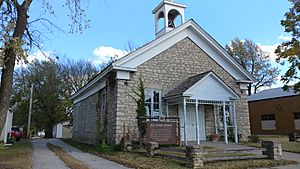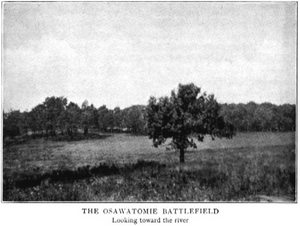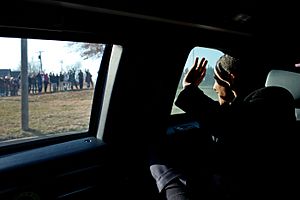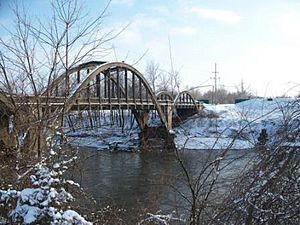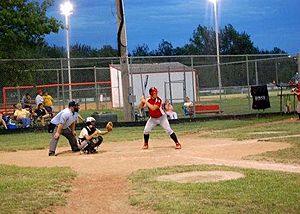Osawatomie, Kansas facts for kids
Quick facts for kids
Osawatomie, Kansas
|
|
|---|---|
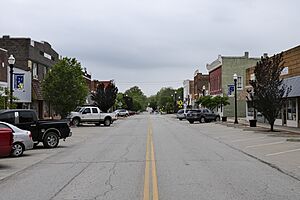
Downtown (2022)
|
|
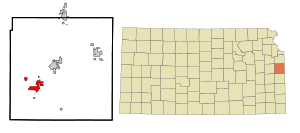
Location within Miami County and Kansas
|
|
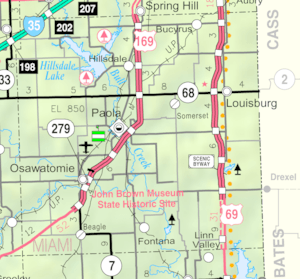
|
|
| Country | United States |
| State | Kansas |
| County | Miami |
| Founded | 1854 |
| Incorporated | 1883 |
| Government | |
| • Type | Mayor–Council |
| Area | |
| • Total | 5.34 sq mi (13.84 km2) |
| • Land | 5.25 sq mi (13.60 km2) |
| • Water | 0.09 sq mi (0.24 km2) |
| Elevation | 889 ft (271 m) |
| Population
(2020)
|
|
| • Total | 4,255 |
| • Density | 796.8/sq mi (307.44/km2) |
| Time zone | UTC-6 (CST) |
| • Summer (DST) | UTC-5 (CDT) |
| ZIP code |
66064
|
| Area code | 913 |
| FIPS code | 20-53225 |
| GNIS ID | 485635 |
Osawatomie is a city in Miami County, Kansas, United States. It is about 61 miles (98 km) southwest of Kansas City. In 2020, about 4,255 people lived in the city. The name Osawatomie comes from two nearby streams. These are the Marais des Cygnes River and Pottawatomie Creek.
Contents
History of Osawatomie
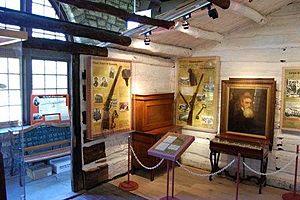
Osawatomie's name comes from two Native American tribes. These tribes were the Osage and Pottawatomie. The town is next to Pottawatomie Creek and the Marais des Cygnes River. These waterways are also named after the two tribes.
The Emigrant Aid Society helped start Osawatomie in October 1854. They brought settlers to the Kansas Territory. These settlers wanted Kansas to join the United States as a free state. This meant they were against slavery. Because of this, Osawatomie and nearby towns faced violence from groups who supported slavery. These groups were called Border Ruffians.
In March 1855, Reverend Samuel Adair and his wife Florella moved to a cabin near Osawatomie. They were missionaries. Florella's half-brother, John Brown, came to Kansas later that year. He brought guns to help fight against slavery. This time was known as "Bleeding Kansas" because of the violence. Brown made the Adair cabin his base. In May 1856, Brown and his followers killed five pro-slavery men. This event was called the "Pottawatomie massacre". It made the fighting in Kansas even worse.
The main Battle of Osawatomie happened on August 30, 1856. Osawatomie was important during the Civil War. It was a center for Jayhawker activity. Jayhawkers were groups who fought against pro-slavery forces.
By 1857, Osawatomie had grown to 800 people. In 1859, the first meeting of the Kansas Republican Party was held there. To honor Osawatomie's role in keeping Kansas a free state, the state opened the Osawatomie State Mental Hospital in 1863. This was the first mental hospital west of the Mississippi River. It is still open today. A railroad was built in 1879, which helped Osawatomie grow. By 1910, the population reached 4,046.
Osawatomie became an official city in 1883. In 1890, it became a second-class city.
The Battle of Osawatomie
The first small fight in Osawatomie happened on June 7, 1856. Not much fighting took place, and no one was hurt. However, buildings were robbed, and horses were taken. The bigger battle, known as the Battle of Osawatomie, started on August 30, 1856. John Brown and his men were camped north of Osawatomie. A group of 250 pro-slavery fighters, led by John William Reid, rode into Osawatomie.
One of John Brown's sons, Frederick Brown, was shot. Reverend Adair sent his own son to warn John Brown about the attack. Brown and 31 of his fighters tried to defend Osawatomie. They fought for over 45 minutes until they ran out of bullets. Brown and his men then left, hoping the attackers would follow them. But instead, Reid's men robbed and burned Osawatomie. Only three buildings were left standing after the battle.
Presidential Visits to Osawatomie
On August 31, 1910, President Theodore Roosevelt gave a famous speech in Osawatomie. It was called the "New Nationalism" speech. He talked about how the government should protect people's well-being and their property rights.
Later, on December 6, 2011, President Barack Obama also gave an important speech in Osawatomie. He spoke about the economy at Osawatomie High School. He repeated many of the ideas that President Roosevelt had talked about.
Geography of Osawatomie
Osawatomie is in the southwest part of Miami County. It is located along US Route 169 and Kansas Highway 7. The Marais des Cygnes River flows north of the city. Pottawatomie Creek flows south of the city.
The city covers about 5.11 square miles (13.23 square kilometers). Most of this area is land, and a small part is water.
Climate in Osawatomie
The weather in Osawatomie has hot and humid summers. Winters are usually mild and dry. This type of weather is called a humid subtropical climate.
Population of Osawatomie
| Historical population | |||
|---|---|---|---|
| Census | Pop. | %± | |
| 1880 | 681 | — | |
| 1890 | 2,662 | 290.9% | |
| 1900 | 4,191 | 57.4% | |
| 1910 | 2,568 | −38.7% | |
| 1920 | 3,293 | 28.2% | |
| 1930 | 4,440 | 34.8% | |
| 1940 | 4,145 | −6.6% | |
| 1950 | 4,347 | 4.9% | |
| 1960 | 4,622 | 6.3% | |
| 1970 | 4,294 | −7.1% | |
| 1980 | 4,459 | 3.8% | |
| 1990 | 4,590 | 2.9% | |
| 2000 | 4,645 | 1.2% | |
| 2010 | 4,447 | −4.3% | |
| 2020 | 4,255 | −4.3% | |
| U.S. Decennial Census | |||
Osawatomie is part of the larger Kansas City metropolitan area.
2020 Census Information
In 2020, there were 4,255 people living in Osawatomie. There were 1,562 households and 1,023 families. Most people were white (87.38%). About 3.22% were Black, and 1.01% were Native American. About 4.28% of the population was Hispanic or Latino.
About 27% of the people were under 18 years old. The average age in the city was 36.1 years.
Historical Places to Visit
Osawatomie has several interesting historical places. Five of them are listed on the National Historic Register.
- The Mills House - This is a large, beautiful home built in 1902. It is designed in the Queen-Anne style.
- Asylum Bridge - This unique bridge was built in 1906. It connects the town to the state mental hospital.
- Creamery Bridge - This bridge was built in 1930 over the Marais des Cygnes River. Another similar bridge crosses Pottawatomie Creek. Both are on the National Historic Register.
- John Brown Museum State Historic Site - This park is where the Battle of Osawatomie took place. You can also see the Adair Cabin there.
- John Brown Lookout - This high point was used as a lookout during the Civil War. You can visit it today.
Other historic places in or near Osawatomie include:
- Midway Drive-In Theater - This is an outdoor movie theater. It is one of only twelve left in Kansas. You can still watch movies there in the spring and summer.
- Flood Marker - A big flood happened in 1951 on the Marais des Cygnes River. A marker shows how high the water reached, which was 50.3 feet.
Community Life in Osawatomie
Osawatomie offers a museum and a driving tour to learn about its history. There are also many fun things to do. You can play at an 18-hole golf course. The Osawatomie City Lake is a great place for fishing.
The USD 367 Sport and Fitness Zone (O-Zone) has two indoor pools and one outdoor pool. It also has a gym, a weight room, and an indoor track. They offer programs for all ages. The Karl E. Cole Sports Complex is used for sports like baseball, softball, soccer, and youth football.
Osawatomie hosts the John Brown Jamboree every summer. This festival features arts, crafts, and music. In October, the Talking Tombstones event takes place at Oakwood Cemetery. People act out historical figures buried there. This helps remember their lives and what they did for the community.
Film in Osawatomie
On March 13, 2010, a short movie called Change for a Dollar was filmed in Osawatomie.
Education in Osawatomie
The public schools in Osawatomie are part of the Osawatomie USD 367 school district.
The four schools are:
- Swenson Early Childhood Education Center (Pre-K and Kindergarten)
- Trojan Elementary (grades 1-5)
- Osawatomie Middle School (grades 6-8)
- Osawatomie High School (grades 9-12)
Notable People from Osawatomie
- John Brown - lived in a cabin here, now the John Brown Museum
- Lynn Dickey - a professional football player
- Derrick Jensen - a professional football player
- Lafayette Russell - a professional football player and actor
See also
 In Spanish: Osawatomie (Kansas) para niños
In Spanish: Osawatomie (Kansas) para niños


